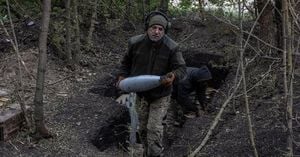The Danube River, a storied waterway that has carried the hopes and dreams of many, became the scene of a harrowing tragedy on the evening of October 5, 2025. A boat carrying at least ten people—primarily Chinese nationals—capsized while attempting a clandestine crossing from Serbia into Croatia. The incident, which unfolded between the Serbian town of Plavna and the Croatian town of Sotin, left one Chinese citizen dead and several others in desperate need of rescue, according to statements from both Serbian and Croatian authorities, as reported by Balkan Insight and Devdiscourse.
Police in Serbia were first alerted to the disaster just before 9 p.m. local time. Within minutes, rescue teams from both Serbia and Croatia were mobilized, racing against the clock to save as many lives as possible from the swirling waters of the Danube. By night’s end, nine people had been pulled to safety—four by Serbian teams and five by their Croatian counterparts. Tragically, the body of one Chinese national was recovered near Backo Novo Selo, confirming the worst fears of those monitoring the unfolding crisis.
According to the Serbian Interior Ministry, the rescued individuals were provided with immediate medical assistance. The Ministry’s statement underscored the gravity of the situation and confirmed that an investigation was underway, focusing on unauthorized border crossing and suspected people-smuggling. The Higher Public Prosecutor’s Office in Novi Sad has officially classified the incident as such, highlighting the increasingly perilous routes migrants are taking across the Balkans in hopes of reaching the European Union.
The Croatian police, for their part, reported that they had received an emergency call about the capsized boat at around 8:45 p.m. (18:45 GMT) on Sunday. Their rescue teams managed to save five people—three men and two women—all Chinese nationals. Dragoljub Zivkovic, a spokesperson for the Vukovar-Srijem police station, told BIRN that Croatian police had rescued five individuals from the Danube but could not yet confirm the total number of people who may have drowned. As the search continued into the early hours of October 6, the Croatian Mountain Rescue Service (HGSS) from Vinkovci Station joined the effort, combing the river for any remaining victims.
Adding another layer of complexity, local media in both Serbia and Croatia reported that a Serbian citizen was steering the boat during the ill-fated crossing. While his involvement has been widely noted, official sources have yet to confirm the operator’s whereabouts or fate. The mystery surrounding his role only deepens the sense of unease surrounding the incident.
As Radio Free Europe/Radio Liberty’s Balkan Service detailed, the boat capsized near Bačka Palanka, a town in northwestern Serbia roughly 90 kilometers from Belgrade. Unofficial reports indicated that the vessel carried ten Chinese citizens and a Serbian national. Emergency services, police, firefighters, and specialized water rescue units from both Serbia and Croatia converged on the scene, their search continuing as daylight broke on October 6. The Serbian Ministry of Internal Affairs, however, had not yet issued an official comment by that time, leaving many questions unanswered for the families and communities affected.
The motivations behind such a risky journey are complex. Serbia lies on the so-called Balkan land route, a well-trodden path for migrants seeking to reach Western Europe. For years, individuals from the Middle East, Africa, and increasingly Asia—including China—have traversed Serbia’s borders in hopes of finding security and opportunity within the European Union. Local media reports suggest that the group of Chinese nationals was attempting to enter Croatia illegally, assisted by the Serbian boat operator. The incident is a stark reminder of the dangers faced by migrants and the persistent challenges of border enforcement and people trafficking in the region.
In recent years, the presence of Chinese emigrants in central and eastern Europe has become more pronounced. This trend is partly attributed to Serbia’s visa-free regime with China, in place since 2017, which allows citizens of both countries to stay or transit for up to 30 days after entry. While many Chinese nationals arrive for business or tourism—drawn by China’s growing investments in Serbian infrastructure and other projects—a subset has sought to use Serbia as a stepping stone to the EU. The tragic events on the Danube underscore the risks inherent in such journeys, especially as people traffickers exploit legal loopholes and desperate circumstances.
According to Devdiscourse, the incident "highlights ongoing issues with illegal border crossings and people trafficking in the region." The investigation launched by Serbian authorities aims to unravel the full circumstances behind the capsizing and to identify those responsible for organizing the illegal crossing. Croatian police, too, have stated their suspicions that the operation was orchestrated by people smugglers, echoing concerns voiced by law enforcement agencies across the Balkans.
Despite the best efforts of rescue teams, the search for additional victims continued as of October 6. Zlatko Becic, head of the Vinkovci Station of the Croatian Mountain Rescue Service, confirmed to BIRN that his team had been searching since the night of the accident. The possibility that others may still be missing casts a long shadow over the rescue operation and serves as a grim testament to the unpredictability of river crossings, especially at night and under clandestine conditions.
The Danube, Europe’s second-longest river, has long been both a lifeline and a barrier. For centuries, it has connected cities and cultures, but it has also served as a formidable obstacle for those seeking to cross its waters illegally. In recent years, the river has become a focal point for migration-related tragedies, as desperate individuals risk everything for a chance at a better life in the EU. This latest incident, with its international cast of victims and rescuers, is yet another chapter in the ongoing saga of migration along the Balkan route.
As investigations proceed on both sides of the border, attention is once again drawn to the broader issues at play: the persistence of people-smuggling networks, the vulnerabilities of migrants, and the challenges faced by border authorities in managing flows of people across complex and often porous frontiers. For the families of those involved—and for the communities along the Danube—the events of October 5-6, 2025, are a stark reminder of the human cost of migration and the urgent need for coordinated action to prevent further tragedies.
With the search still ongoing and many questions left unanswered, the Danube’s swift current carries not only the memories of those lost but also the hopes for safer journeys ahead.





